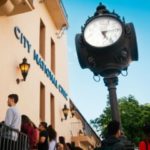I stood outside the iconic Flinders Street railway station. I walked on the field at AAMI Park as thousands of rugby fans cheered. I explored the cozy bars and boutique restaurants lining the laneways just off Swanston Street.
Actually, I haven’t physically been to all of those places. But when I attended the 2016 Asia-Pacific Meetings and Incentives Expo (AIME) at the Melbourne Convention and Exhibition Centre on Feb. 23–24, I could see even more of the Australian city thanks to the event technology in AIME’s redesigned Community Hub. The centrally located area on the show floor offered attendees an opportunity to immerse themselves in 360-degree views of the world’s most livable city (for five years running, according to The Economist magazine) via virtual-reality and 3D-visualization tools like Gear VR by Oculus and Google Cardboard binoculars.
We wanted to develop a deconstructed environment versus the rest of the traditional booths.
 Throughout the show, the living room was packed with AIME participants looking to recharge. They needed the extra energy, too. More than 500 exhibiting companies and more than 4,500 industry professionals came together for two busy days of hosted-buyer appointments at the show, which is owned by the Melbourne Convention Bureau (MCB) and produced by Reed Travel Exhibitions. Many of the exhibitors saw new faces — 47 percent of hosted buyers were new to AIME.
Throughout the show, the living room was packed with AIME participants looking to recharge. They needed the extra energy, too. More than 500 exhibiting companies and more than 4,500 industry professionals came together for two busy days of hosted-buyer appointments at the show, which is owned by the Melbourne Convention Bureau (MCB) and produced by Reed Travel Exhibitions. Many of the exhibitors saw new faces — 47 percent of hosted buyers were new to AIME.
But the numbers only tell part of AIME’s story. “We know events need to serve a business purpose and deliver ROI, but we also know that people in this industry love what they do,” said Ian Wainwright, AIME’s event director. “So we have to take a head and a heart approach. After all the networking and the business discussions, we still need to give them reminders about why they love this industry and how each of them can continue to help strengthen it.”
Wainwright’s approach to designing AIME is grounded in his own experience in Melbourne. While this is his first year as the show’s event director, he’s attended as a hosted buyer eight times, and used many of his own perspectives to help shape this year’s program, which included a range of compelling speakers that reinforced the “heart” side of AIME’s balance. When Turia Pitt, an Australian ultramarathon runner who recovered from a near-fatal fire, spoke, it was tough to find a dry eye anywhere in the room.
When attendees weren’t learning, networking, or drawing inspiration from speakers like Pitt, they needed to get down to business, and Wainwright and his team worked to make each appointment effective. “Your time is very limited here,” Wainwright said, “so we examined our buyer and exhibitor matching process to make sure that all our participants can make the most out of the AIME experience.”
Their work seemed to pay off. Gary Khan, CEO of the Hyderabad Convention Visitors Bureau in India, has been participating in AIME for the past four years. After the first day of the 2016 program, Khan told me that it was the most valuable one yet. “The quality of the hosted buyers has improved dramatically,” he said.
The exhibitor portfolio looked equally impressive. In 2016, AIME welcomed new exhibitors such as the Thailand Convention & Exhibition Bureau, the Korea Tourism Organisation, and the Turkish Ministry of Culture & Tourism. As Karen Bolinger, the MCB’s CEO, looks ahead to the continuing evolution of the 24-year-old show, she expects to see even more new faces and places represented. “AIME started out small,” Bolinger said. “It was initially a way to showcase Melbourne as a leader in the business-events space. Then, it expanded to the rest of Australia and on to all of the APAC region.
“Now, it’s very global,” Bolinger said. “You’ll find everyone from Las Vegas to Turkey on the show floor. It won’t be long before the rest of the world is on our doorstep.”




